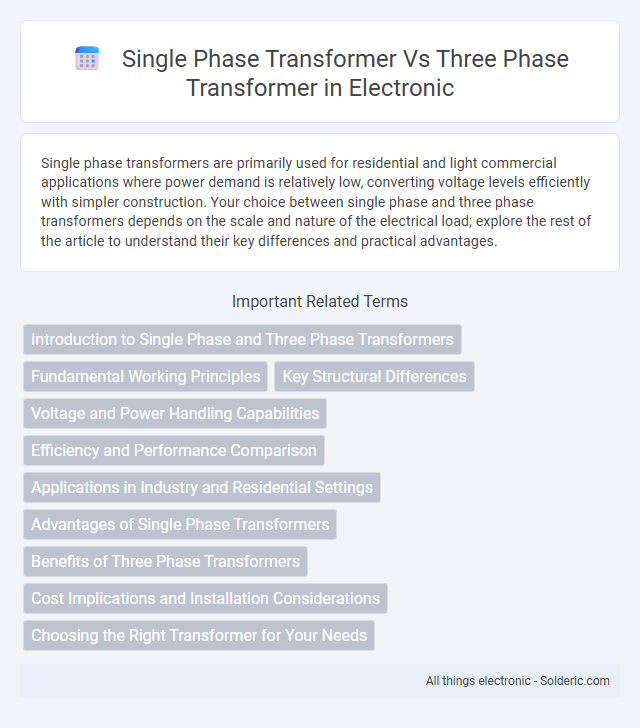Single phase transformers are primarily used for residential and light commercial applications where power demand is relatively low, converting voltage levels efficiently with simpler construction. Your choice between single phase and three phase transformers depends on the scale and nature of the electrical load; explore the rest of the article to understand their key differences and practical advantages.
Comparison Table
| Aspect | Single Phase Transformer | Three Phase Transformer |
|---|---|---|
| Phases | One phase | Three phases |
| Construction | Simple core, two coils | Three single-phase cores or one three-limb core |
| Voltage Levels | Up to low and medium voltage | Medium and high voltage transmission |
| Size & Weight | Smaller, lighter | Larger, heavier |
| Efficiency | Lower compared to three phase | Higher, better load handling |
| Applications | Residential, small loads | Industrial, commercial, power distribution |
| Cost | Lower initial cost | Higher initial cost but economical for large loads |
| Maintenance | Simple maintenance | More complex maintenance |
Introduction to Single Phase and Three Phase Transformers
Single phase transformers operate with a single alternating current and are commonly used in residential and light commercial applications, providing voltage regulation for lower power demands. Three phase transformers utilize three alternating currents, delivering balanced power for industrial and large commercial settings with higher efficiency and capacity. Both types transform voltage levels to meet specific electrical system requirements, but three phase transformers are preferred for heavy-duty applications due to their superior power handling and reduced energy losses.
Fundamental Working Principles
Single-phase transformers operate on the principle of electromagnetic induction, transferring electrical energy between two coils through a magnetic core with a single alternating voltage input, ideal for residential and light commercial use. Three-phase transformers consist of three single-phase transformers interconnected or a built-in three-phase core, enabling efficient power distribution with balanced loads and reduced losses in industrial and utility-scale applications. Your choice depends on the power requirements and system configuration, as single-phase transformers suit smaller loads while three-phase transformers support larger, continuous power demands.
Key Structural Differences
Single phase transformers consist of two windings--primary and secondary--on a single core, making them simpler and more compact for lower power applications. Three phase transformers have three sets of primary and secondary windings, often arranged on a three-limb or five-limb core to handle balanced loads in power distribution systems efficiently. Your choice depends on the power requirements and system design, as three phase transformers provide greater power capacity and reliability than single phase models.
Voltage and Power Handling Capabilities
Single phase transformers typically handle lower voltage and power levels, making them suitable for residential and small commercial applications with loads up to a few kilowatts. Three phase transformers are designed for higher voltage and power ratings, commonly used in industrial environments to support heavy machinery, large motors, and power distribution systems exceeding several hundred kilowatts. The efficiency and load balancing capabilities of three phase transformers enable better performance for complex electrical systems compared to single phase units.
Efficiency and Performance Comparison
Single-phase transformers generally exhibit lower efficiency and performance compared to three-phase transformers due to increased copper losses and less effective core utilization. Three-phase transformers deliver superior efficiency, often exceeding 98%, by balancing load across three coils and reducing energy losses during power transmission. Their performance benefits include improved voltage regulation and greater power handling capacity, making them ideal for industrial and large-scale applications.
Applications in Industry and Residential Settings
Single phase transformers are extensively used in residential settings to power household appliances and lighting systems due to their simplicity and cost-effectiveness. Three phase transformers dominate industrial applications, providing efficient power distribution for heavy machinery, motors, and large-scale HVAC systems. The higher power capacity and balanced load handling of three phase transformers make them ideal for commercial and industrial environments.
Advantages of Single Phase Transformers
Single phase transformers offer simplicity, lower initial cost, and easier maintenance, making them ideal for residential and light commercial applications. Their compact design and ability to operate efficiently at lower power levels provide advantages for your localized power distribution needs. Single phase transformers also require less complex wiring, which reduces installation time and overall expenses.
Benefits of Three Phase Transformers
Three phase transformers offer higher efficiency and reduced power losses compared to single phase transformers, making them ideal for industrial and commercial power distribution. They provide balanced load handling and smoother power delivery, enhancing the stability and reliability of your electrical system. The compact design and cost-effectiveness of three phase transformers also contribute to lower installation and maintenance expenses.
Cost Implications and Installation Considerations
Single phase transformers generally have lower initial costs and simpler installation processes suitable for residential or small-scale applications, while three phase transformers involve higher upfront expenses due to more complex construction but offer cost efficiency in large-scale industrial or commercial power distribution. Installation of single phase units requires less space and simpler wiring, whereas three phase transformers demand more careful site preparation, balancing loads, and specialized equipment, impacting overall installation time and labor costs. Choosing between the two depends on power capacity needs, budget constraints, and the complexity of the electrical system design.
Choosing the Right Transformer for Your Needs
Selecting the appropriate transformer depends on the application's power requirements and load characteristics. Single phase transformers are ideal for residential and light commercial use where loads are smaller and simpler, while three phase transformers better suit industrial or large commercial settings with higher power demands and more complex electrical systems. Understanding factors such as voltage levels, power capacity, efficiency, and installation costs helps ensure the right choice between single phase and three phase transformers.
single phase transformer vs three phase transformer Infographic

 solderic.com
solderic.com